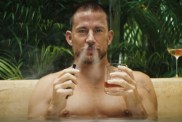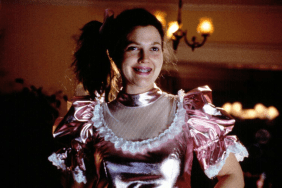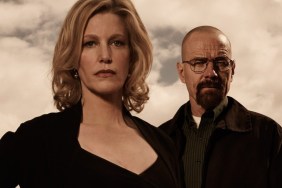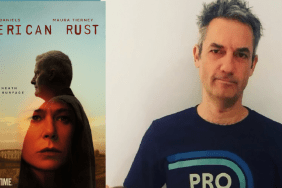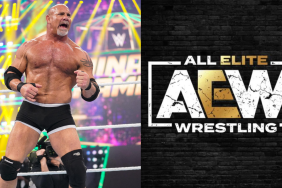In his 2004 Disney movie Miracle, filmmaker Gavin O’Connor retold the story of the 1980 Olympic hockey team and how they went on to defeat insurmountable odds to take the Gold Medal from the Russian favorites. Four years later, O’Connor’s follow-up Pride and Glory explored a family of New York City police officers at odds, and in some ways, the director’s latest, Warrior combines these two ideas into a family drama within the environment of what’s becoming one of the most popular sports in our country after NASCAR (and baseball, football, basketball – you know, all the regulars)… Mixed Martial Arts.
Warrior stars Joel Edgerton (Animal Kingdom) and Tom Hardy (Inception, upcoming The Dark Knight Rises) as brothers Brendan and Tommy, who have not seen each other in over a decade following a rift that tore their family apart. Brendan remained with their alcoholic father Paddy (Nick Nolte), started his own family and after a few years as a fighter, switched gears and became a science teacher; Tommy went off with his abused mother before joining the Marines and going to Iraq. Tommy has returned to the East Coast, not to reconnect or make amends, but to get back in fighting shape, but when he knocks out a MMA champ in a sparring match, he’s seen as a serious contender. Meanwhile, Brendan’s financial problems lead him to fighting again, despite the complications it causes at work and home. Within months, the two brothers are both after the same goal as they make their way to Atlantic City for a monumental MMA tournament.
Warrior is already being hailed as one of the best movies of the year and being compared favorably to the likes of Rocky, which might make it the first movie based in MMA that is able to break through to other audiences. It’s certainly one of the few sports movie that doesn’t just limit its appeal to men, since the family dynamics and accompanying performances by Edgerton, Hardy, Nolte and Jennifer Morrison (as Brendan’s wife Tess) are some of the best you’re likely to see in a movie this year.
ComingSoon.net got on the phone with Gavin O’Connor to talk to him about the movie.
ComingSoon.net: I know this has kind of been in development going back to “Pride and Glory,” so I guess the most obvious question is how did you get into the world of MMA and why did you decide to set a movie there?
Gavin O’Connor: Roughly 10 years ago, I executive produced a documentary called “The Smashing Machine,” which is about Mark Kerr, a MMA fighter. This is in the early, early UFC days before any real fights were sanctioned in this country. He was doing a lot of fighting in Brazil and the Pride tournaments in Japan. That was my introduction to MMA and then I just had a sort of love affair with it ever since then.
CS: When you started writing this and working on the script, did you already have consultants from the MMA involved or did you know enough about it from doing the documentary to work on the script?
O’Connor: Well, I knew enough about it to put it down on paper, but the actual texture of it and the deepening of details and verisimilitude, all that stuff, I started once I finished. I knew the movie was going to get made, then I just started hanging around a lot of fighters, going to a lot of fights. When I say going to fights, I wasn’t just sitting there watching them, I was in the back in the locker rooms because what I was interested in was the preparation, what happens before a guy walks out into the cage. I was fortunate enough through my friend Charles Lewis, also known as Mask, who is the owner of TapouT, I was fortunate enough to have access to a lot of fights.
CS: Are they fairly open to having outsiders back there? I feel like preparing for matches must be really tough on a guy to know that he potentially could get beaten up pretty bad.
O’Connor: No, they were. I mean, the only reason I was let in was because of Charles. Charles was sort of an institution. He’s dead now. I don’t know if you noticed, but I dedicate the movie to him, but he sort of opened up the door and he said, “Let Gavin in.” Charles called the guys to do it, they did it because everyone trusted Charles, so I had a very sort of behind the scenes kind of access that I would never have had if it wasn’t for Charles.
CS: It’s an interesting tie to your previous movie “Pride and Glory” because it’s also a family drama, but centered in a very different genre, and it’s also a two-handed story – two stories going separately then coming together. Did it influence how you approached this one in terms of the writing and storytelling?
O’Connor: Well, (with) “Pride and Glory”… personally, my father was a cop in New York City, so I grew up in that world. I think that there was just an intimacy to that movie and a sort of a kitchen sink drama kind of feel to that film that I’m very comfortable with, but I also wanted to deliver a film that had, on a larger scale hopefully, the emotional power of something like “Miracle,” where you have a big kind of ending. It’s driving towards something powerful emotionally. The problem with “Miracle” was that you know how the movie’s going to end before it starts, so that has its own challenges, but this being an original story, I just wanted that. I was trying to like, take both of those kind of ideas of the kitchen sink drama and the big inspirational kind of emotional powerhouse kind of finale and kinda change splice them.

CS: It’s interesting you bring that up because that’s the general problem with sports movies in that they can only end one way or another–they win or they don’t–and this one opens things up to a lot more gray area, so that you don’t know who to root for and you don’t know who’s going to win. You really don’t know where it’s going to go. (SPOILER WARNING for “Rocky” in this response and a little bit for “Warrior” as well – no, we’re not kidding.)
O’Connor: Well, that was also the intentions. So if I’m going to do this now, how do I do it differently? I didn’t want to just recycle what’s already been out there. That’s the challenge. So what I was going to go for here, which you’ve never seen in a movie is, I’m going to have you root–because usually like you’re saying, you’re rooting for whoever you’re rooting for whether it’s Rocky or the Olympic team. You know who you’re rooting for, and then however it ends, they usually win, or in Rocky’s case, he did win because he just went 12 rounds. That was his win. He didn’t have to beat him, he just had to go the distance. What I was going for here was this idea that you’re rooting for two different people and they’re on a collision course and now you’re faced with a choice when they have to fight each other. That, to me, felt fresh and original and challenging also because the trick was, how do I get the audience to be rooting for the two of them? That’s not that hard, but then, when they have to face each other on an unconscious level, by the time we get to that fourth round, the audience has to unconsciously hopefully start rooting for Brendan to win because Brendan’s win is winning where Tommy’s win is losing. So, and it’s a very delicate thing because it’s not a conscious decision, but it has to feel when it’s over, that that’s sort of like surprising yet inevitable. It was the only way this should end because Tommy needs to lose to win. If Tommy won, it’s disastrous kind of. He needs to die to be reborn. He needed to die at the hands of his brother.
CS: You were able to get these two actors at such an incredible time before they had exploded. If you tried getting either of them now it’d be much harder I’d imagine. I assume you saw “Bronson” and knew that Tom had the physicality to do this. What about Joel? He hadn’t really done a role like this, which was very physical as far as I can remember.
O’Connor: Well, I hadn’t seen “Bronson” when I cast Tom. I saw “Bronson” afterwards. I cast Tom before that movie was at Sundance, but in regards to Joel, he just had qualities that were right for the part. As I discovered, Joel is a really good athlete. Everyone had to go through like a little mini camp just to see what their physical capabilities were, and Joel’s very, very athletic. But the other thing about Joel as an actor, which was the qualities I was looking for Brendan was Joel as a person, he just has integrity. He’s a gentleman. He’s a really good guy. He’s the kind of guy you want in your foxhole. But also, and this was crucial for the part, so I needed a guy, Brendan is a character living in his higher self. He’s a great father, great husband and really trying hard to be an upstanding citizen, but you need to also look at him and go, “I could believe that guy, when he was living in his lower self, or a younger guy, that he could’ve been a barroom brawler. He could’ve been a drinker.” He had that in him too, and that was a hard thing to find with an actor.
CS: Had you seen any films he’d done before or did both of them just come out of auditions?
O’Connor: Yeah, I just auditioned. I just auditioned. When I met Joel, he came out to my house and I met him, then he auditioned and just hanging out with him in person. I also had gotten an audition of his where he did a monologue from “Henry IV” that really knocked my socks off. So I knew how much talent this guy had as an actor and I knew his athleticism. I also knew him as a person, what kind of integrity he had and he just had all the qualities I was looking for.
CS: What’s crazy about the pairing of them is that the two of them only have a few scenes together. When you were shooting this, did you really try to keep them apart to help build that tension for when they actually had those scenes together? Was it not really feasible when making the movie?
O’Connor: Well, it was actually very easy because I never shot with them on the same day, so when I was shooting with Tommy, Joel was never even on set. He wasn’t around. Then when I was shooting with Joel, Tommy wasn’t around. I remember the first time Tommy saw the movie he was like, “Wow, I can’t believe how great Joel is.” He goes, “Because I had no – I didn’t see Joel.” He just didn’t know what the hell Joel was doing when we were shooting his stuff.
CS: When I talked to them at Comic-Con–they were both at Comic-Con doing interviews together–it was really weird because they had such good chemistry, but you couldn’t really tell from the movie because their only scenes together they’re fighting. You had access to the MMA guys and you had real guys who knew how to stage these fights, but you’re also mixing and matching, because you have the two actors in the ring with real fighters. So how did you go about choreographing and figuring out how to shoot the fights?
O’Connor: Well, it started with a particular style – I said to my fight guys I didn’t want the Hong Kong kind of fighting. It had to be all grounded in reality. I needed to have seen it in real life in a fight. On YouTube, we went through hundreds of fights, but I needed to have seen it for us to even think about putting it in the movie because I didn’t want anything in the movie that hasn’t actually been done and I could point and say everything in that film I’ve seen. We’ve seen it and whether it may not be in a UFC fight, it may have been a Pride fight or a fight in Brazil, but I’ve seen it. The challenge was getting the actors obviously to be in really good shape, and they trained really hard. They had great coordinators and choreographers. We worked really hard at getting all the fights right.

CS: What was it like shooting those fight sequences? I talked to someone who was at the arena in Pittsburgh when you were filming, so did you just have two or three days with an audience to shoot all the fights?
O’Connor: Well, it was difficult. I mean, you always want more people, so you’re moving the background a lot wherever you’re pointing the camera. You keep moving background so the background is filled. It was tough on the actors because in boxing you can have 10, 12 ounce gloves and then you can even pad them and cushion them so if you hit somebody with a boxing glove that’s cushioned, it doesn’t hurt that much, especially if you’re pulling your punches. But with MMA gloves that are four ounces, and these guys were getting hit because you can’t help it sometimes, it’s hard. It hurts. So, it was really a matter of designing our days where we do a certain amount of hours of shooting fights and then I would go off into a locker room or a hallway or a corridor and shoot drama because I couldn’t have these guys fighting all day. It was beating them up.
CS: With the extras in the audience, were you able to have any full fights that they could watch and react to or were there a lot of reactions pieced together?
O’Connor: Well, what I would do is, when I had cameras on the fighters and my extras in the background, that was all very surgical and very technical and we had to choreograph them, so it was almost like choreographing a dance, so you do it in beats of like one, two, three, four. Then, I’d get that. We never did the whole fight. You can never do it, it’s impossible. But that being said, when I was shooting just crowds and you get the right reactions, I would have guys fight, not my actors. I’d have real fighters get in there and do things and then I’d get a truthful reaction.
CS: Also you have Kurt Angle playing one of the fighters, which is pretty amazing. How did you work with him? Did he change his fighting style for this? It’s funny seeing Joel get in the ring with Kurt Angle. If I were an actor, I’d just say, “No, get my stunt person to do that.” Could you talk about getting Kurt Angle to play that role?
O’Connor: To be honest, I wanted a Russian. I based him loosely on Fedor, his character, Koba. I wanted a Russian, but to get a Russian that would stay in Pittsburgh the amount of time I needed a guy to be there because you don’t shoot in sequence, so I would need him to be there for probably two months or six weeks, it would’ve been very expensive and we just didn’t have it in the budget. So now I was limited to having to find somebody on the Pittsburgh, Pennsylvania, Ohio area. Then, to find a Russian fighter in Pittsburgh or the area (Laughs) was not easy to find. So then, it was a hard decision. I wasn’t going to get a Russian guy and then I opened it up there and then Kurt came in. I honestly didn’t know who Kurt was. I never watched WWE, so probably for his sake, it was good that I didn’t know him because once I found out I was actually–I’m like, “I don’t know if I want a WWE guy in this movie.” But he was the best guy for the part and he’s great, he’s great. You know Kurt can do the stunts because of his WWE background, so he knows how to sell a punch and throw a punch and not kill somebody. So he took all his talents doing that. Kurt’s great, he’s great. I’m really happy with him in the movie.
CS: Although this is a drama, I think one of the reasons people like the movie so much is because there’s quite a bit of humor whether it comes from Kevin Dunn as the school principal or the ring announcers, so was that stuff heavily scripted or did you let those guys improvise stuff?
O’Connor: Well, it started with casting Bryan Callen who is very funny. Then the other guys, Sam Sheridan who is a fight author. He wrote a book called “A Fighter’s Heart,” which is sort of in the MMA world. Everyone knows “A Fighter’s Heart.” A lot of it was, there were certain things that were written, certain things that were improv-ed, then when I was putting the movie together, when you hear them and you don’t see them, a lot of times we would write that stuff later and have them come in and ADR it later. But by design, I wanted humor there and lightness because it’s a heavy movie and I just wanted to make sure I was balancing it when it was appropriate and never getting forced, just some levity. So that was a consciously intended thing.
CS: A bit of a tangent, but I wanted to ask about Nick Nolte’s character and the fact that he’s listening to “Moby Dick” on tape, which becomes this running narrative through the movie. Where did that come from and why did you decide to have that? It becomes a pretty big part of his character the more we see it used.
O’Connor: Well, there was a thing that didn’t end up in the movie, but in a draft we had where the old man Paddy got drunk on books. So he put away the bottle, but he replaced his addictions with reading books. It started with reading books, and then he would travel the world and globe trot through the pages of his books because he never left his chair in Pittsburgh. Then my co-writer Anthony said, “What if we made it books on tape?” I was like, “Oh dude, that’s a great idea because then we can hear what he’s reading as he’s listening,” so that just added another sort of sonic element that was just a brilliant idea. The reason I chose “Moby Dick” was because – and I don’t want to get all deep about this stuff because it goes into God, and Tommy was railing against God the whole movie. I mean, that’s what he’s doing. But this idea for Tommy, Paddy is the white whale. There’s only one white whale in the ocean. When you read “Moby Dick,” there’s only one white whale in the ocean and Ahab is hunting that f*cking whale down because the whale bit his leg off.

CS: It’s a fairly long movie, but did you have to cut a lot out of it? It ends in a way that leaves things rather open-ended, but did you shoot a lot more stuff you didn’t use?
O’Connor: No. I mean, some of the stuff I just took out of it in the writing part after several drafts because it just felt too much. It was becoming such a beast of a movie that it would’ve been a three-hour film, but the DNA of it just stayed in there and you just kind of feel it, so that’s just what Paddy’s–I hope the audience will get a sense that–I mean, you see Tommy when he goes over to the mantle in the house the first time he comes home. You do see the books on tape. There’s “The Count of Monte Cristo” and some other novels on books on tape there. So, I hope that the audience, if they see that, you get a sense that’s what this guy’s world is. When Tommy enters his life, he happens to be listening to “Moby Dick.”
CS: I appreciated the lack of exposition and the fact you let people figure things out by themselves rather than throwing stuff in their face. Any idea what you want to do next? Obviously this has been done for a couple of months now at least. Are you working on something else? Do you have any other projects you might go back to?
O’Connor: Well, I have two pieces I just wrote that I’m going to see. One of them I wrote for Warner Brothers and another one is just an original spec that I haven’t even gone out with yet, I just finished it. It’s called “The Samurai.” So I don’t know. I’m going to probably do one of those two scripts.
CS: I imagine after “Miracle” you got a lot of offers to direct things and you went and did a very personal story instead. After this, I assume it’s going to happen again because it’s just such a well made movie. How are you feeling now? Do you feel like you have to keep on working on the things you’re working on as far as a writer?
O’Connor: Yeah, I want to create my own stuff. I always say to my agents, you go through one of these big kind of movies, everyone makes money, but like, I said, “I’m the one who’s gotta go make it and if I don’t have my heart in it, and it’s like a love affair, I’m not going to do a good job. Then, and I don’t want to just get paid. I just, I don’t want to do that.” So, I’m feeling very grateful and fortunate to be able to do this and I don’t know how long it will last. At least I want to be making films that are somehow born out of me that are stories I want to tell. The challenge is figuring out how to do it where you can make them personal, yet still deliver to an audience a film experience that is satisfying and emotional, and that’s what I’m trying to do. But, my intention is to be writing my own stuff.
CS: I’m glad I got a chance to talk to you about this movie. It’s really an amazing movie. I hope people will find it over the course of the theatrical run.
O’Connor: Well, spread the word, man. We need it because we don’t have big movie stars and there’s a lot of parts of this country like the flyover states where it’s a little harder to get people to go to the movies if you’re not a movie star. So we kind of believe it’s a word-of-mouth film. So if people like it, if they can tell other people, that’s going to be really helpful.
CS: I think you’ll find Tom has become a bigger star just by being in “The Dark Knight Rises” even though it doesn’t come out for 11 months. A lot of people are talking about Bane and saying, “Well if you see ‘Warrior’ you’ll get some idea of why he must’ve been cast,” because he has the physicality of Bane in this.
O’Connor: Well that’s cool. I hope you’re right, my friend. (Laughs)
Warrior opens nationwide on Friday, September 9, but it will have sneak previews over Labor Day weekend, so check your local theater listings to see if it’s playing in your area early.

